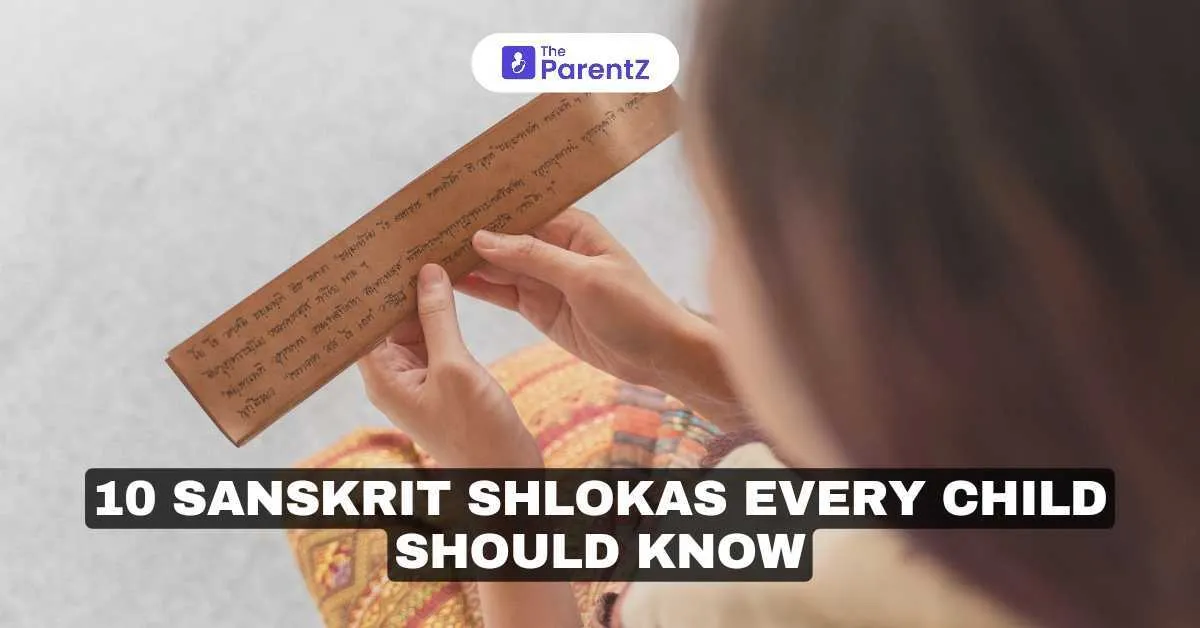Sanskrit, a language as ancient as the stars, whispers tales of wisdom and wonder.
Isn’t it amazing how ancient wisdom can still light up our lives today? One of the treasures of Indian culture is the beautiful language of Sanskrit, filled with shlokas that carry deep meanings and life lessons. Teaching our kids these shlokas can be a wonderful way to connect them with their roots and impart valuable values. So, let’s dive into ten enchanting Sanskrit shlokas every child should know!
#1. Gayatri Mantra
ॐ भूर् भुवः स्वः।
तत् सवितुर्वरेण्यं।
भर्गो देवस्य धीमहि।
धियो यो नः प्रचोदयात् ॥
[Om bhur bhuvah swaha,
tat savitur varenyam,
bhargo devasya dhimahi,
dhiyo yo nah prachodayat.]
Translation: O God, the Creator of the universe, may you illuminate our minds and guide us towards the path of wisdom.
Why Kids Should Know It: This mantra is a prayer for enlightenment and knowledge. Reciting it helps children start their day with positivity and encourages them to seek knowledge. It teaches them the value of learning and intellectual growth.
#2. Shanti Mantra
ॐ सह नाववतु ।
सह नौ भुनक्तु ।
सह वीर्यं करवावहै ।
तेजस्वि नावधीतमस्तु मा विद्विषावहै ।
ॐ शान्तिः शान्तिः शान्तिः ॥
[Om Saha Nau-Avatu |
Saha Nau Bhunaktu |
Saha Viiryam Karavaavahai |
Tejasvi Nau-Adhiitam-Astu Maa Vidvissaavahai |
Om Shaantih Shaantih Shaantih ||]
Translation: May the Almighty protect both the teacher and the student. May we work together with strength and wisdom, and may there be no animosity between us. May there be peace.
Why Kids Should Know It: This mantra fosters a sense of unity and respect between teachers and students. It teaches children the importance of collaboration and harmony in learning environments.
#3. Maa Saraswati Vandana
या देवी सर्वभूतेषु दया-रूपेण संस्थिता।
नमस्तस्यै नमस्तस्यै नमस्तस्यै नमो नमः॥
[Ya Devi Sarva Bhuteshu Vidya Rupen Samasthita,
Namastasye Namastasye Namastasye Namo Namah.]
Translation: Salutations to the Goddess who embodies knowledge in all beings.
Why Kids Should Know It: This shloka honors Goddess Saraswati, the deity of wisdom and learning. It inspires children to value education and strive for intellectual excellence.
#4. Mahalakshmi Vandana
नमस्तेऽस्तु महामाये श्रीपीठे सुरपूजिते ।
शङ्खचक्रगदाहस्ते महालक्ष्मि नमोऽस्तुते ॥१॥
[Namastestu Mahamaye, Shri Pithe Sura Pujite,
Sankha Chakra Gada Haste, Mahalakshmi Namostute.]
Translation: Salutations to the great Goddess who is worshiped by all deities and holds the conch, discus, and mace.
Why Kids Should Know It: This shloka invokes blessings for wealth and prosperity from Goddess Lakshmi. It teaches children about hard work and gratitude for abundance in life.
#5. Durga Mantra
सर्वमङ्गलमाङ्गल्ये शिवे सर्वार्थसाधिके ।
शरण्ये त्र्यम्बके गौरि नारायणि नमोऽस्तु ते ॥
[Sarva mangal mangalye, Shive sarvarth sadhike,
Sharanye triyambake gauri, Narayani namostute.]
Translation: Salutations to you, O Narayani! You are auspiciousness itself; you fulfill all desires; you are the protector of all beings.
Why Kids Should Know It: This shloka praises Goddess Narayani as a source of goodness and fulfillment. By learning this verse, children understand the importance of seeking blessings for well-being and success in their endeavors.
#6. Vakratunda Mahakaya
वक्रतुण्ड महाकाय सूर्यकोटि समप्रभ ।
निर्विघ्नं कुरु मे देव सर्वकार्येषु सर्वदा ॥
[Vakratunda Mahakaya, Suryakoti Samaprabha,
Nirvighnam Kurume Deva, Sarva Karyeshu Sarvada.]
Translation: O Lord Ganesha, who has a curved trunk and a massive body, may you remove all obstacles from my endeavors.
Why Kids Should Know It: This mantra is a powerful invocation to Lord Ganesha for overcoming challenges. It instills confidence in children that they can face difficulties with determination.
#7. Hare Krishna Mantra
हरे राम हरे राम
राम राम हरे हरे हरे
कृष्ण हरे कृष्ण
कृष्ण कृष्ण हरे हरे
[Hare Krishna Hare Krishna,
Krishna Krishna Hare Hare;
Hare Rama Hare Rama,
Rama Rama Hare Hare]
Translation: O Lord Krishna and Rama, I offer my devotion to you.
Why Kids Should Know It: This simple yet profound mantra promotes spiritual growth and connection with divine energies. It encourages children to embrace love and compassion in their lives.
#8. Guru Vandana
गुरुर्ब्रह्मा गुरुर्विष्णु
गुरुर्देवो महेश्वर :
गुरु साक्षात् परं ब्रह्म
तस्मै श्री गुरवे नम : ।
[Guru Brahma Guru Vishnu
Guru Devo Maheshvarah;
Guru Sakshat Param Brahma
Tasmai Shri Guruve Namah.]
Translation: The Guru is Brahma (the creator), Vishnu (the preserver), and Shiva (the destroyer). I bow down to my Guru.
Why Kids Should Know It: This shloka emphasizes respect for teachers as guides in life. It teaches children the importance of honoring those who impart knowledge.
#9. Shanti Mantra
ॐ असतो मा सद्गमय।
तमसो मा ज्योतिर्गमय।
मृत्योर्मा अमृतं गमय।
ॐ शांतिः शांतिः शांतिः ॥
[Asatoma Sadgamaya;
Tamaso Ma Jyotir Gamaya;
Mrityor Ma Amritam Gamaya;
Om Shanti Shanti Shantih.]
Translation: Lead me from untruth to truth; from darkness to light; from death to immortality. Let there be peace.
Why Kids Should Know It: This mantra is a beautiful prayer for peace and enlightenment. It helps children understand the importance of seeking truth and light in their lives.
#10. Vidyaarthi Sloka
विद्यार्थी लभते विद्यां, धनार्थी लभते धनम्।
पुत्रार्थी लभते पुत्रान्-मोक्षार्थी लभते गतिम्
[Vidyaarthee lapathey vidyaam; Dhanaarthee lapathey dhanam;
Puthraarthee lapathey puthraan; Mokshaarthee lapathey gathim.]
Translation: The seeker of knowledge gains knowledge; the seeker of wealth gains wealth; the seeker of children gains children; the seeker of liberation gains liberation.
Why Kids Should Know It: This shloka teaches that sincere efforts lead to fulfillment in various aspects of life—knowledge, wealth, family, and spiritual growth. It encourages children to pursue their dreams with dedication.
Conclusion
These ten shlokas, like seeds of wisdom, have the power to transform young minds. Children can develop a strong foundation of values, ethics, and intellectual prowess by including them in daily routines. Let us nurture the next generation with the timeless wisdom of Sanskrit, empowering them to become compassionate, intelligent, and successful individuals.








Be the first one to comment on this story.